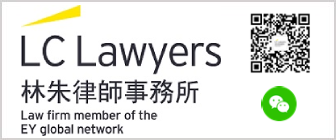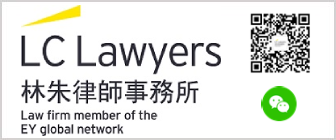Rossana Chu (Managing Partner)
Email: rossana.chu@eylaw.com.hk
The principles on sustainable bonds (ICMA Bond Principles) formulated by the International Capital Market Association (ICMA) are widely applied in Hong Kong listed bonds, as discussed in our previous articles1. External reviews play an important part in green, social and sustainability-lined bonds/loans, and the author will summarize the common types of external reviews here.
Common types of external reviews
The Guidelines for Green, Social, Sustainability and Sustainability-Linked Bonds External Reviews2 of the ICMA group external reviews in four main types, namely, second party opinion, verification, certification and rating/scoring.
The “Green Loan Principles”3, the “Social Loan Principles”4 and the “Sustainability-Linked Loan Principles”5 issued by the Loan Market Association, the Asia-Pacific Loan Market Association and the Loan Syndications and Trading Association (LMA Loan Principles) also highlight the functions of external reviews.
(1) Second party opinion
Alignment of the bond/loan framework with international principles
A second party opinion usually comments on whether the green, social, sustainability and sustainability-linked bond/loan framework is in line with the international principles (such as the ICMA Bond Principles and the LMA Loan Principles). It is given by an independent institution with environmental/ social/ sustainability expertise.
For green and social bonds/loans, the following aspects are often considered in giving the second party opinion:
Use of proceeds:
- Eligible projects or project categories covered in the bond/loan framework of the issuer/borrower
- Sustainability objectives of each project category
- Nature of uses, e.g. capital expenditure, research & development
- Excluded projects and activities
Process for project selection and evaluation:
- Section process and eligibility criteria used, e.g. international or market-practice standards and taxonomies, science-based targets, self-developed sustainability benefit indicators
- Target period of fully applying the net proceeds
- Committees or departments participating in the selection and their respective roles
- Regulatory approvals required before carrying on the projects
- How the associated environmental and social risks are monitored and mitigated
- Regular reviews on the continuity in project eligibility
Management of proceeds
- Whether the proceeds are placed in a designated account or sub-account, or in a general account with a register to track the uses
- How the proceeds are used before being allocated to eligible projects, and the commitment of not using the unallocated proceeds on activities that conflict with the eligibility criteria
- How to re-allocate the proceeds to an alternative eligible project if a designated project ceases to be eligible
Reporting
- Frequency of reporting
- Contents of reporting, e.g. allocation of proceeds to eligible projects, qualitative and quantitative expressions of sustainability impacts for each project, balance of unallocated proceeds, proportion of financing versus refinancing
- Whether post-issuance third-party verification or certification reports will be issued
Sustainable Development Goals
Seventeen Sustainable Development Goals (SDGs) were adopted by the United Nations in 20156 as a universal call to end poverty, protect the planet, and achieve peace by 2030. Mindful of the SDGs, all countries should recognize that development must balance social, economic and environmental sustainability.
Second party opinions often include mapping of the proceeds uses to SDGs. ICMA provides a broad frame of reference on SDG mapping, and sets out a table illustrating the relevance of 15 SDGs to the uses of proceeds7. Nevertheless, each project should be reviewed individually as to whether it aligns with any particular SDG.
| SDG | Green Bond Principles of ICMA project categories |
Social Bond Principles of ICMA project categories |
| 1. No Poverty |
|
|
| 2. No Hunger |
|
|
| 3. Good Health and Well-being |
|
|
| 4. Good Education |
|
|
| 5. Gender Equality |
|
|
| 6. Clean Water and Sanitation |
|
|
| 7. Affordable and Clean Energy |
|
|
| 8. Decent Work and Economic Growth |
|
|
| 9. Industry, Innovation and Infrastructure |
|
|
| 10. Reduced Inequalities |
|
|
| 11. Sustainable Cities and Communities |
|
|
| 12. Responsible Consumption and Production |
|
|
| 13. Climate Action |
|
|
| 14. Life Below Water |
|
|
| 15. Life on Land |
|
|
Contribution of the sustainable finance to the sustainability strategy of the issuer/borrower
A second party opinion may start with the issuer’s/borrower’s sustainability strategy. It then discusses how the sustainable bond/loan and its framework can actualize the strategy and lead to positive environmental and social outcomes. The reviewer may also comment on that quantitative results which may be achieved through the sustainable finance, e.g. extent of electricity consumption reduction, contribution to carbon offset, creation of affordable houses, increase in recycle content, reduction in waste. References can be made to international benchmarks such as the Science-Based Targets Initiative8.
Notwithstanding the benefits, eligible projects could create environmental and social risks, e.g. employee injuries, negative environmental impacts and production of harmful materials at the construction and operation stages, unbalanced allocation of affordable resources amongst vulnerable groups, safety issues of new products. The opinion may report on how the issuer/borrower manages the risks via its policies, trainings, compliance with regulations, as well as how the issuer/borrower works with employees, suppliers, customers, regulators, local communities and other stakeholders to assess and mitigate the risks.
(2) Verification
It refers to an independent verification on the bond/loan framework or the underlying projects against a designated set of internal sustainability criteria.
In the case of a sustainability-linked bond/loan, it is a must to obtain independent and external verification on measuring performance against the key performance indicators or on the progress of achieving the sustainability performance targets. According to the ICMA Sustainability-Linked Bond Principles9 and the LMA Sustainability-Linked Loan Principles, the verification must be conducted at least once a year, and at the time for assessing whether an adjustment to the bond/loan characteristics is triggered, until after the last trigger event has been reached.
A bond issuer usually reports, at least once a year, on the proceeds amounts applied to eligible projects. Some issuers of Hong Kong listed bonds engage professional firms (including EY) to examine and provide limited assurance in certain assertions set out in the issuer’s post-issuance reports, in order to give comfort to investors. The professional firm reviews the issuer’s procedures on the project selection and proceeds management, implementation of the procedures, calculations performed and disclosure policies. The conclusion is normally taken in the form of a negative statement as to whether anything has come to the professional firm’s attention that causes it to believe the assertions do not meet the requirements of the relevant international principles or the issuer’s bond framework.
(3) Certification
The issuer/borrower can engage a qualified and independent third party to certify its sustainable bond/loan, the relevant framework, use of proceeds, key performance indicators and sustainability performance targets against recognised external sustainability standards which define specific criteria.
(4) Rating/scoring
A third-party rating agency or specialized research provider may evaluate or assess the sustainable bond/loan framework, use of proceeds, selection of key performance indicators, calibration of the level of ambitiousness of sustainability performance targets SPTs, according to an established scoring/rating methodology.
Although rating and scoring are not very common, certain bonds listed in Hong Kong have been scored via evaluation approaches encompassing sustainability benefits, governance (proceeds management and impact assessment structure) and transparency in reporting.
Key takeaway
Bond issuers and loan borrowers are engaged to make good use of external reviews, because they promote best practice for the issuer’s/borrower’s internal control, allow stakeholders to understand how the bond/loan framework is aligned with international principles, and give comfort to investors on how their monies are channeled to sustainable uses.
1 https://www.eylaw.com.hk/en_hk/publications/our-latest-thinking/2022/may/application
2 https://www.icmagroup.org/sustainable-finance/external-reviews
3 https://www.lsta.org/content/green-loan-principles/
4 https://www.lsta.org/content/social-loan-principles-slp/
5 https://www.lsta.org/content/sustainability-linked-loan-principles-sllp/
6 https://www.undp.org/sustainable-development-goals
7 https://www.icmagroup.org/assets/documents/Regulatory/Green-Bonds/June-2020/Mapping-SDGs-to-Green-Social-and-Sustainability-Bonds-2020-June-2020-090620.pdf
8 https://www.wri.org/initiatives/science-based-targets
9 https://www.icmagroup.org/sustainable-finance/the-principles-guidelines-and-handbooks/sustainability-linked-bond-principles-slbp/



